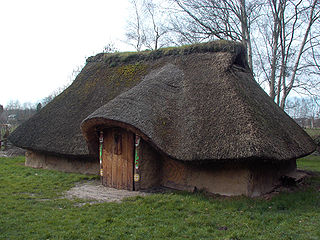Related Research Articles

The Menapii were a Belgic tribe dwelling near the North Sea, around present-day Cassel, during the Iron Age and the Roman period.
The Viducassēs were a Gallic tribe dwelling in the modern Calvados department during the Iron Age and the Roman period.

The Vellavii were a Gallic tribe dwelling around the modern city of Le Puy-en-Velay, in the region of the Auvergne, during the Iron Age and the Roman period.

The Aulerci Cenomani were a Gallic tribe dwelling in the modern Sarthe department during the Iron Age and the Roman period. The Cenomani were the most powerful of the Aulerci tribes.

The Bodiocasses or Baiocasses were an ancient Gallic tribe of the Roman period. They were a tribal division of the civitas of the Lexovii, in the Roman province of Gallia Lugdunensis.

The Rauraci or Raurici were a small Gallic tribe dwelling in the Upper Rhine region, around the present-day city of Basel, during the Iron Age and the Roman period.
The Abrincatui were a Gallic tribe dwelling in the south of the Cotentin Peninsula during the Roman period.

The Parisii were a Gallic tribe that dwelt on the banks of the river Seine during the Iron Age and the Roman era. They lived on lands now occupied by the modern city of Paris, whose name is derived from the ethnonym.
The Alauni were a Gallic tribe dwelling around the lake Chiemsee during the Roman period.

The Ambiani were a Belgic coastal tribe dwelling in the modern Picardy region during the Iron Age and Roman periods.

The Redones or Riedones were a Gallic tribe dwelling in the eastern part of the Brittany peninsula during the Iron age and subsequent Roman conquest of Gaul. Their capital was at Condate, the site of modern day Rennes.

The Elusates were an Aquitani tribe dwelling in the modern Gers department, around present-day Eauze, France during the Iron Age and the Roman period.
The Caerosi were a small Belgic-Germanic tribe dwelling in Gallia Belgica during the Iron Age and the Roman period. Their ethnic identity remains uncertain. Caesar described them as part of the Germani Cisrhenani, but their tribal name is probably of Celtic origin. Like other Germani Cisrhenani tribes, it is possible that their old Germanic endonym came to be abandoned after a tribal reorganization, that they received their names from their Celtic neighbours, or else that they were fully or partially assimilated into Celtic culture at the time of the Roman invasion of the region in 57 BC.
The Catalauni were a Belgic tribe dwelling in the modern Champagne region during the Roman period. The Catalauni probably belonged to a larger tribe, either the Remi in the north or the Lingones in the south. The Catuvellauni, who migrated to southern Britain in the 1st century BC, are likely part of the same tribal group.
The Silvanectes were a small Belgic tribe dwelling around present-day Senlis (Oise) during the Roman period.
The Sentii were a small Gallic tribe dwelling around present-day Senez, in southeastern France, during the Roman era.
The Savincates were a Gallic tribe dwelling in the Ubaye valley, around present-day Faucon-de-Barcelonnette in the Alpes Maritimae, during the Iron Age.
The Sogionti or Sogiontii were a Gallic tribe dwelling around present-day Sisteron during the Iron Age.
The Sebaginni were a Gallic tribe dwelling in the middle Durance valley during the Iron Age.
The Rucinates or Rucantii were a Gallic tribe dwelling in near the confluence of the Isar and Danube rivers during the Roman period.
References
- ↑ Notitia Dignitatum oc 5:52, 53, 201, 202; 7:25, 128.
- 1 2 Falileyev 2010, s.v. Brisigavi.
- ↑ Jungandreas 1978.
- ↑ Talbert 2000, Map 11: Sequana-Rhenus, Map 12: Mogontiacum-Reginum-Lauriacum, Map 18: Augustonemetum-Vindonissa.
Bibliography
- Falileyev, Alexander (2010). Dictionary of Continental Celtic Place-names: A Celtic Companion to the Barrington Atlas of the Greek and Roman World. CMCS. ISBN 978-0955718236.
- Jungandreas, Wolfgang (1978). "Breisgau". In Beck, Heinrich (ed.). Reallexikon der Germanischen Altertumskunde. Vol. 3 (2 ed.). De Gruyter. ISBN 978-1314391893.
- Talbert, Richard J. A. (2000). Barrington Atlas of the Greek and Roman World. Princeton University Press. ISBN 978-0691031699.